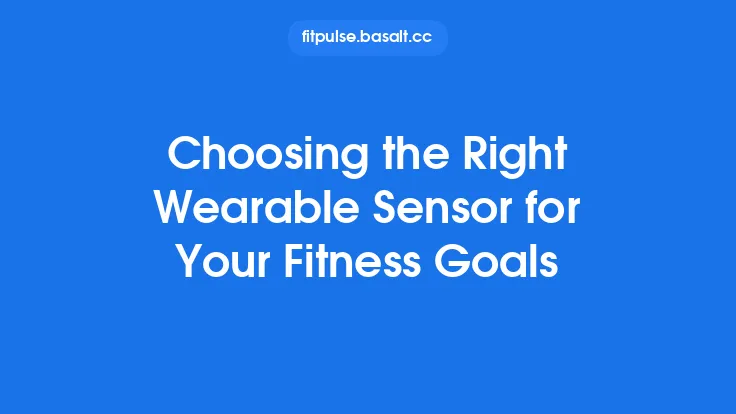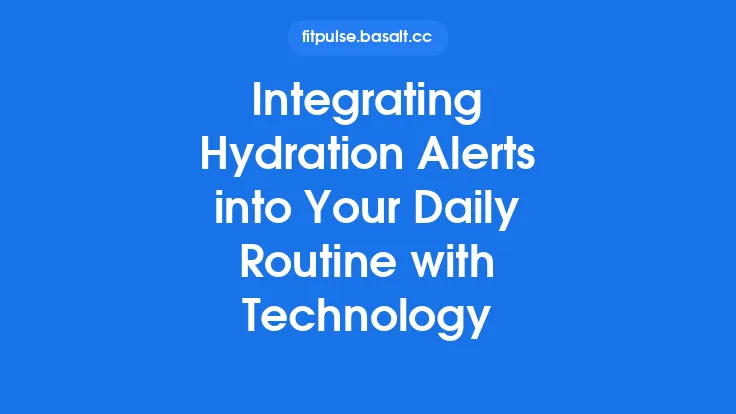Integrating wearable sensor data with third‑party platforms has become a cornerstone of modern fitness ecosystems. As users adopt multiple devices—heart‑rate straps, GPS watches, smart shoes, and even smart clothing—the demand for seamless data exchange grows. Developers, product managers, and data engineers must therefore design integration pipelines that are reliable, scalable, and adaptable to evolving standards. This article walks through the end‑to‑end process of moving raw sensor streams from a wearable into external services such as health dashboards, social fitness apps, and enterprise analytics platforms. It covers the technical building blocks, architectural patterns, and practical considerations that keep integrations robust over time.
Understanding Data Flow from Wearables to Platforms
- Sensor Capture Layer
- Wearable firmware samples raw signals (e.g., photoplethysmography, inertial measurements) at predefined rates.
- Data is timestamped using the device’s internal clock, often synchronized via NTP or Bluetooth time‑exchange protocols.
- Edge Processing Layer
- Basic preprocessing (filtering, artifact removal, feature extraction) occurs on‑device to reduce bandwidth and power consumption.
- Typical outputs include heart‑rate, step count, cadence, VO₂ max estimates, and sleep stages.
- Transport Layer
- Data is transmitted to a companion smartphone or hub using Bluetooth Low Energy (BLE) GATT profiles, ANT+, or Wi‑Fi Direct.
- The transport protocol must handle intermittent connectivity, packet loss, and reconnection logic.
- Gateway/API Layer
- The companion app aggregates data, batches it, and forwards it to a cloud endpoint via HTTPS.
- APIs may be RESTful, GraphQL, or use MQTT for real‑time streaming.
- Third‑Party Platform Ingestion
- External services expose ingestion endpoints (e.g., Apple HealthKit, Google Fit, Strava) that accept standardized payloads.
- Platforms often provide SDKs or webhook mechanisms for push‑based updates.
Understanding each of these layers helps you pinpoint where integration logic belongs and where you can offload work to existing services.
Standard Protocols and Data Formats
| Protocol | Typical Use | Key Characteristics |
|---|---|---|
| BLE GATT | Device‑to‑phone communication | Defined services (e.g., Heart Rate Service, Running Speed and Cadence) with characteristic UUIDs. |
| ANT+ | Multi‑device ecosystems (e.g., bike sensors) | Low‑latency broadcast, widely used in cycling and rowing. |
| HTTPS/REST | Cloud ingestion | Stateless, widely supported, easy to test with tools like Postman. |
| MQTT | Real‑time streaming to dashboards | Publish/subscribe model, lightweight, supports QoS levels. |
| WebSockets | Bi‑directional live updates | Persistent connection, useful for live coaching apps. |
| Open mHealth | Interoperability across health platforms | JSON schema for common health concepts (e.g., `heartrate`, `stepcount`). |
| FHIR (Fast Healthcare Interoperability Resources) | Clinical-grade data exchange | Rich resource model, supports extensions for fitness data. |
Choosing a format that aligns with the target platform reduces transformation overhead. For example, Apple HealthKit expects data in the HealthKit data model, while Strava’s API consumes activity objects defined in its own JSON schema.
Authentication and Authorization Mechanisms
Third‑party platforms rarely allow unauthenticated data pushes. The most common mechanisms include:
- OAuth 2.0
- Users grant permission to your app to write data on their behalf.
- Use the Authorization Code flow for server‑side integrations; Implicit flow for pure client‑side apps.
- Refresh tokens enable long‑lived access without re‑prompting the user.
- API Keys
- Simpler but less secure; suitable for internal services where the key is stored in a vault.
- Rotate keys regularly and enforce IP whitelisting where possible.
- Signed JWTs (JSON Web Tokens)
- Useful for server‑to‑server communication (e.g., pushing aggregated data from a cloud function to a corporate analytics platform).
- Include claims such as `iss` (issuer), `sub` (subject), and `exp` (expiration) to limit token lifespan.
Implement token storage using a secrets manager (AWS Secrets Manager, Azure Key Vault) and enforce least‑privilege scopes (e.g., `activity.write` rather than `activity.*`).
Designing Scalable Data Pipelines
A robust pipeline must handle spikes (e.g., marathon events) and maintain low latency for real‑time features. A typical architecture looks like:
- Ingestion Endpoint – A load‑balanced HTTPS API gateway (AWS API Gateway, Azure API Management) that validates payloads and authenticates requests.
- Message Queue – Decouples ingestion from processing (Amazon SQS, Google Cloud Pub/Sub).
- Stream Processor – Real‑time enrichment (e.g., calculate calories from heart‑rate zones) using Apache Flink, AWS Kinesis Data Analytics, or Azure Stream Analytics.
- Data Lake – Immutable storage for raw and processed data (Amazon S3, Azure Data Lake Storage).
- Warehouse – Structured tables for analytics (Snowflake, BigQuery, Redshift).
- API Layer for Third‑Party Consumption – Exposes normalized data via REST/GraphQL endpoints or pushes via webhooks.
Horizontal scaling is achieved by adding more consumer instances to the queue and stream processor. Monitoring (CloudWatch, Azure Monitor) should track queue depth, processing latency, and error rates.
Data Normalization and Interoperability
Wearables from different manufacturers may report the same metric in varying units or with different precision. Normalization steps include:
- Unit Conversion – Convert all distances to meters, speeds to meters/second, and heart‑rate to beats per minute (BPM).
- Timestamp Alignment – Convert device timestamps to UTC, handling clock drift by applying offset corrections from NTP sync logs.
- Schema Mapping – Map vendor‑specific fields to a canonical model (e.g., `hr` → `heartrate`, `stepstotal` → `step_count`).
- Quality Flags – Attach metadata indicating signal quality (e.g., `hr_quality: 0.85`) to allow downstream consumers to filter noisy data.
Adopting an open schema such as Open mHealth’s `PhysicalActivity` or FHIR’s `Observation` resource ensures that third‑party platforms can ingest data without custom adapters.
Real‑Time vs Batch Integration Strategies
| Aspect | Real‑Time Integration | Batch Integration |
|---|---|---|
| Latency | Seconds to minutes (ideal for live coaching, alerts) | Hours to days (suitable for weekly reports) |
| Complexity | Requires streaming infrastructure, stateful processing | Simpler; can rely on scheduled ETL jobs |
| Reliability | Must handle transient network failures; use replay mechanisms | Easier to retry whole batch if a job fails |
| Cost | Higher due to always‑on services (e.g., Kinesis) | Lower; compute runs only during scheduled windows |
| Use Cases | Live heart‑rate zones, instant social sharing, safety alerts | Monthly fitness summaries, research data exports |
A hybrid approach often works best: stream critical metrics in real time while aggregating less time‑sensitive data in nightly batches.
Leveraging Cloud Services for Storage and Analytics
- Time‑Series Databases – InfluxDB, TimescaleDB, or Amazon Timestream excel at storing high‑frequency sensor data and support down‑sampling for long‑term retention.
- Serverless Functions – AWS Lambda, Azure Functions, or Google Cloud Functions can perform lightweight transformations (e.g., unit conversion) without managing servers.
- Machine Learning Pipelines – Use services like Amazon SageMaker or Azure ML to train models on historical activity data (e.g., predicting fatigue levels) and expose inference endpoints for real‑time scoring.
- Visualization – Connect data warehouses to BI tools (Looker, Power BI) or embed custom dashboards using libraries like D3.js for user‑facing analytics.
Choosing managed services reduces operational overhead and allows the team to focus on domain logic rather than infrastructure plumbing.
Common Integration Use Cases
- Social Fitness Sharing
- Push activity summaries to platforms like Strava or Garmin Connect via their REST APIs.
- Include metadata such as route GPX files, elevation gain, and personal best flags.
- Corporate Wellness Programs
- Aggregate anonymized step counts and active minutes into an HR analytics dashboard.
- Use OAuth scopes limited to aggregate metrics to respect employee privacy.
- Clinical Research
- Export heart‑rate variability and sleep metrics to a secure FHIR server for longitudinal health studies.
- Ensure data is de‑identified according to institutional review board (IRB) requirements.
- Personalized Coaching Apps
- Subscribe to real‑time heart‑rate streams via MQTT, compute zone‑based alerts, and send push notifications to the user’s phone.
- Store session data for post‑workout analysis and recommendation generation.
- Insurance Telemetry
- Provide insurers with activity logs (e.g., daily step totals) to qualify for wellness discounts, using signed JWTs for secure transmission.
Each use case dictates a different balance of latency, security, and data granularity.
Testing, Monitoring, and Debugging
- Contract Tests – Use tools like Pact to verify that your API payloads conform to third‑party specifications before deployment.
- Synthetic Traffic – Simulate device data streams with tools like Locust or k6 to stress‑test ingestion endpoints.
- Observability Stack – Deploy OpenTelemetry agents to capture traces across the pipeline; correlate request IDs from device to third‑party endpoint.
- Alerting – Set thresholds for queue depth, error rates, and latency; integrate alerts with PagerDuty or Opsgenie.
- Versioning – Maintain backward‑compatible API versions; use semantic versioning for payload schemas.
A disciplined testing regime catches integration breakages early, especially when third‑party platforms roll out API changes.
Security Considerations Beyond Privacy
While privacy best practices are covered elsewhere, integration pipelines must still address broader security concerns:
- Transport Encryption – Enforce TLS 1.2+ for all external communications; disable weak cipher suites.
- Input Validation – Sanitize all incoming JSON/XML to prevent injection attacks; enforce strict schema validation.
- Rate Limiting – Apply per‑client throttling to protect against denial‑of‑service (DoS) attacks from compromised devices.
- Audit Logging – Record who accessed or modified data, including timestamps and IP addresses, to support forensic analysis.
- Secret Management – Rotate API keys and OAuth client secrets regularly; store them in encrypted vaults with access control policies.
- Compliance Checks – If handling health‑related data, ensure the pipeline meets regulatory requirements (HIPAA, GDPR) even if privacy policies are handled elsewhere.
Embedding these controls into the CI/CD pipeline (e.g., using Snyk or Trivy for container scanning) helps maintain a secure posture over time.
Future‑Proofing Your Integration Architecture
- Modular Adapters – Encapsulate each third‑party connector behind a common interface. Adding a new platform then requires only a new adapter implementation.
- Schema Evolution – Use versioned JSON schemas and maintain a migration layer that can translate older payloads to the current model.
- Event‑Driven Design – Favor publish/subscribe patterns; this decouples producers (wearables) from consumers (analytics, social platforms) and eases scaling.
- Edge Intelligence – As wearables gain more on‑device AI, anticipate receiving higher‑level insights (e.g., “fatigue detected”) that may require new data fields.
- Standard Adoption – Keep an eye on emerging standards such as IEEE 11073‑20601 (Personal Health Device Communication) and the Continua Health Alliance specifications, which aim to unify health‑device data exchange.
By building with flexibility in mind, you reduce the effort needed to incorporate new sensors, platforms, or regulatory changes.
Conclusion
Integrating wearable sensor data with third‑party platforms is a multi‑layered challenge that blends hardware constraints, network protocols, data modeling, and cloud architecture. A successful integration strategy starts with a clear understanding of the data flow from sensor to server, adopts open standards for interchange, secures communication through robust authentication, and leverages scalable cloud services for processing and storage. By normalizing data, choosing the right real‑time or batch approach, and implementing thorough testing and monitoring, developers can deliver reliable experiences that power social sharing, corporate wellness, clinical research, and personalized coaching. Finally, designing modular, version‑aware adapters and staying aligned with emerging interoperability standards ensures that today’s integration remains functional and valuable as the wearable ecosystem continues to evolve.



